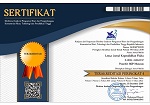RELEVANSI ANTARA PROGRAM STUDI KEAHLIAN TEKNIK BANGUNAN DENGAN PEKERJAAN YANG DIPEROLEH LULUSAN SMK DI KABUPATEN LOMBOK BARAT
DOI:
https://doi.org/10.33394/j-lkf.v1i2.206Keywords:
relevancy, steel construction, wood construction, stone and concrete construction, construction sketchAbstract
The purpose of the study is to know the information of the relevancy of civil engineering expertise study program on occupation obtained by the graduates of Secondary Vocational School in Lombok Barat regency. Data was gathered by using questionnaire analysis from 50 graduates of civil engineering expertise study program of 2007 and 2008 academic years and data was analyzed by using descriptive technique. The findings show that (1) the relevancy of occupation, expertise, and knowledge for steel construction technique has means of 12.20, 8.92 and 10.37 respectively and those three belong to irrelevant category; (2) the relevancy of occupation, expertise, and knowledge for wood construction technique has means of 38.86, 28.00, and 32.41 respectively, and those three belong to irrelevant category; (3) the relevancy of occupation, expertise, and knowledge for stone and concrete construction technique has means of 70.73, 54.88, and 65.85 and those three belong to relevant category; (4) the relevancy of occupation, expertise, and knowledge for construction sketch has means of 82.04, 65.32, and 81.15, and those three belong to relevant category.
References
Baskoro, D. 2009. Kontribusi Tes Untuk Kerja Buatan Industri dan Guru Terhadap Hasil Uji Kompetensi Nasional Siswa Program Keahlian TMO Tahun 2007/2008 Pada SMK Se-Kota Mojokerto. Tesis tidak diterbitkan. Malang: Program Pascasarjana UM.
Dwitagama, D. 2008. Siswa SMK dipersiapkan untuk siap kerja setelah lulus sekolah, (Online), (http://dedidwitagama.wordpress.com/2008/02/08/mau-kerja-masuk-smk-aja/, diakses 22 September 2010).
Hadi, Sutrisno. 1980. Metodologi research. Yogyakarta: ANDI.
Herianto. 2009. Pengembangan Program Keahlian Teknologi Hasil Pertanian, (Online), (http://www.pengembangan-program-keahlian-teknologi.html, diakses 7 Juni 2010).
Kompas. 26 Januari, 2010. 2014, 70 Persen Lulusan SMK Terserap Pasar Kerja, (Online), (http://www.2014..70.Persen.Lulusan.SMK.Terserap.Pasar.Kerja.htm, diakses 13 Maret 2010)
Kompas. 25 Maret, 2009. Hanya 30 Persen Pekerjaan Sesuai Pendidikan, (Online), (http://www.1id1240.html, diakses 13 Maret 2010)
Peraturan Pemerintah Republik Indonesia Nomor 19 tahun 2005 tentang Standar Nasional Pendidikan. 2008. Bandung: Citra Umbara.
Sukamto. 1988. Perencanaan & Pengembangan Kurikulum Pendidikan Teknologi dan Kejuruan. Jakarta: Departeman Pendidikan dan Kebudayaan Direktorat Jenderal Pendidikan Tinggi Proyek Pengembangan Lembaga Pendidikan Tenaga Kependidikan
Yunus, M. 2006. Kebijakan Kemitraan Pendidikan Kejuruan. Malang: Pustaka Kayutangan.
Downloads
Published
How to Cite
Issue
Section
License
Authors who publish with Lensa: Jurnal Kependidikan Fisika agree to the following terms:
- For all articles published in Lensa: Jurnal Kependidikan Fisika, copyright is retained by the authors. Authors give permission to the publisher to announce the work with conditions. When the manuscript is accepted for publication, the authors agree to automatic transfer of the publishing right to the publisher.
- Authors retain copyright and grant the journal right of first publication with the work simultaneously licensed under a Creative Commons Attribution-ShareAlike 4.0 International License that allows others to share the work with an acknowledgment of the work's authorship and initial publication in this journal.
- Authors are able to enter into separate, additional contractual arrangements for the non-exclusive distribution of the journal's published version of the work (e.g., post it to an institutional repository or publish it in a book), with an acknowledgment of its initial publication in this journal.
- Authors are permitted and encouraged to post their work online (e.g., in institutional repositories or on their website) prior to and during the submission process, as it can lead to productive exchanges, as well as earlier and greater citation of published work (See The Effect of Open Access).

This work is licensed under a Creative Commons Attribution-ShareAlike 4.0 International License.



